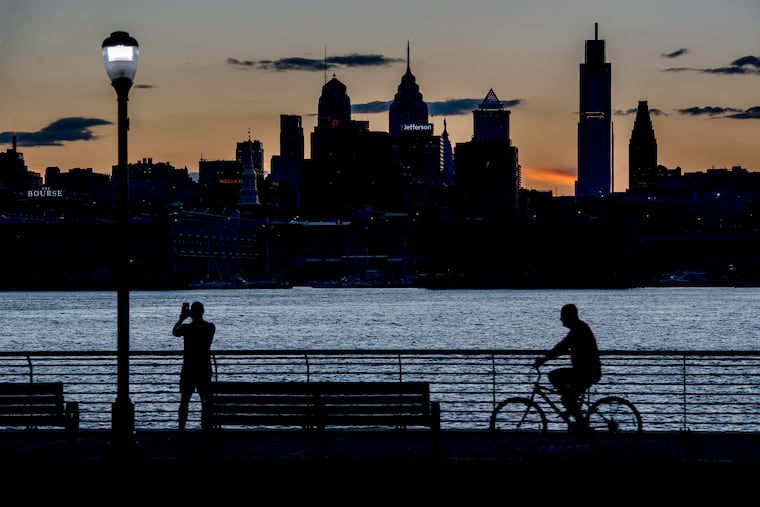Fall arrives in Philly on Thursday. What to know about the only season of the year with two names.
The monarch butterflies are preparing for takeoff to Mexico, and, yes, we might see those elusive northern lights this fall.

At 9:03 p.m. Eastern Thursday, for an instant the sun will beam its direct light over the equator — just off the northeast coast of Australia — and the only season of the year with two names will begin officially.
To mark the occasion we explore some of the cosmic — and prosaic — questions associated with the season, second only to winter for brevity.
What’s with the two names?
“Autumn” is derived from the Latin word autumnus, but just how the ancient Romans came up with that one has gone the way of the Forum.
Likewise, precisely when “fall” became an acceptable nickname is a mystery. It first appeared in Samuel Johnson’s Dictionary of the English Language, in 1755, according to Merriam-Webster. “Fall” was a huge hit in North America, where the appetite for Latin declensions and the like was limited. American linguist John Pickering wrote in 1816 that the season was “universally called the fall.”
Why? Sometimes the obvious is true. Things are falling like crazy out there, including the night.
How fast is night falling?
Fast.
The Philadelphia area is in the peak light-loss season. The sunrise-to-sunset period Thursday will be 2 minutes and 37 seconds shorter than it was Wednesday. Throughout September, we will lose an hour and 14 minutes of daylight.
This will slow down as we approach the winter solstice, and then head in the other direction.
Wednesday was a benchmark in that the sun will set in Philly before 7 p.m. — 6:59:27 p.m. — for the first time since the clocks moved forward in March. That would be 12 hours, 14 minutes, and 15 seconds of daylight.
Wait a minute, doesn’t “equinox” suggest equal day, equal night?
Not just yet, at least not around here. The days and nights will be closest to equal on Sept. 27. Astronomy gets complicated.
What are the chances of seeing the northern lights this fall?
The periods around the equinoxes appear to be prime time for the northern lights, a connection first documented by a British Jesuit priest astronomer in 1912. That has something to do with how the solar and earthly magnetic fields interact, says EarthSky.org.
And the longer nights would allow for a wider viewing window of opportunity. Based on the Space Weather Prediction Center’s long-term outlook, on Oct. 1 the lights could be visible as far south as northern New England; however, these forecasts are as volatile as the aurora.
Rob Steenburgh, acting lead of the space weather office, has said he likes our chances of seeing the aurora this fall.
In the meantime, for a sure thing, says Franklin Institute astronomer Derrick Pitts, enjoy Jupiter “bright and easy to spot” high in the east about 9 p.m. Thursday.
What’s with all the pumpkins?
We are living in a veritable pumpkin patch. Pennsylvania ranks among the top states in pumpkin-growing, according to the U.S. Department of Agriculture and other sources, producing a hefty 81.6 million pounds in 2021.
That’s $22 million worth of pumpkin.
What can you do with a pumpkin after Halloween?
“I have seen people spray-paint them gold for Christmas,” says Kathy Bartman of Wilcox Farms in Boyertown. “I’ve also seen pumpkins painted white and stacked as snowmen.”
You also can carve your pumpkin and eat it too. Nutritional experts note they are far less caloric than the average pumpkin-spice latte, and they advise saving and roasting seeds. They caution that the popular “decorative” pumpkins aren’t the greatest for cooking. And should you carve one, stick a candle in it, and leave it outside for a couple of days, let the chipmunks party away. “The animals are always grateful for extra food,” said Wilcox.
Hippopotami evidently love them, by the way. Watch the Philadelphia Zoo’s Cindy and Unna, weighing in at a svelte 4,000 pounds each and neither dieting, devour them like gum drops.
What do monarch butterflies eat to pork up for a 3,000-mile flight?
Their diets aren’t quite as varied as Unna’s and Cindy’s. In their caterpillar phase, monarchs live solely on milkweed leaves. For their incredible annual autumn migrations, mature monarchs belly-up on a smorgasbord of nectars. They have to. They fly up to 3,500 miles to Mexico, and while they over-winter they eat little or nothing, says the U.S. Forest Service.
When is the first frost?
With worldwide warming, the growing seasons are growing longer, but poet Emily Dickinson’s “blond assassin” that beheads flowers keeps showing up annually.
Fixing a date is tricky, however, because frost can occur at temperatures well above freezing, with moist air and calm winds. On average, frost first appears on Oct. 31 in Philly; on Oct. 14 in Coatesville; and on Oct. 13 in Millville, says Alex Staarmann, meteorologist at the National Weather Service in Mount Holly.
How soon might it snow?
The earliest measurable snow in Philly, 2.1 inches, occurred on Oct. 10. 1979, 17 days after the equinox.
Only 90 days to winter.